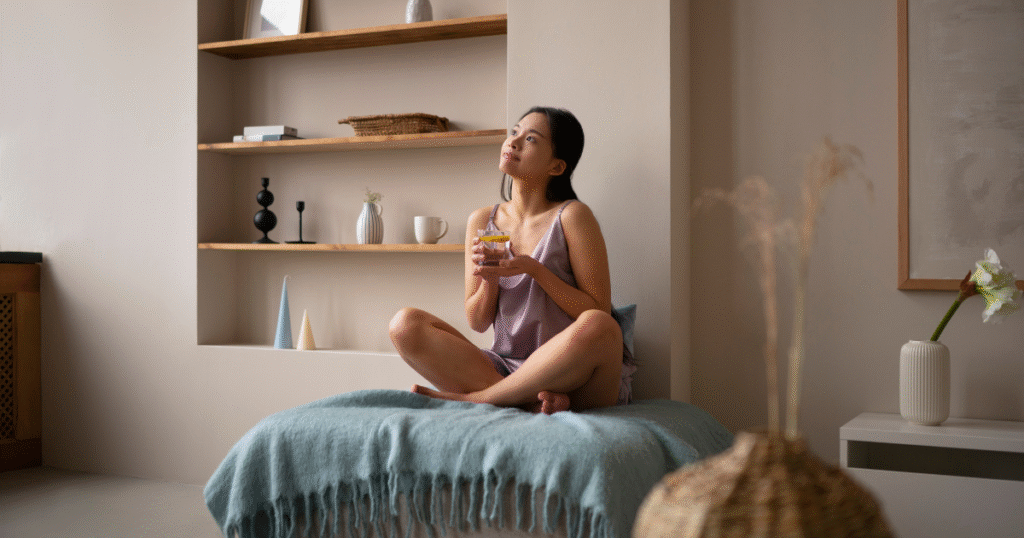It’s the year 2025 and it’s no longer acceptable to think that busy means important. If we’re being honest, most days, we just move from one thing to another—whether that concerns work or errands. The result? At the workplace, 82% of employees are at risk of burnout. Worldwide, 63% of consumers now prioritize mental health more than they did five years ago. This is when slow living tips become even more helpful.
As much as we would like companies and wellness brands to be more accountable, change can also begin with us. We don’t mean dropping everything to go off the grid. Slow living doesn’t require a shopping spree either. There are powerful slow living tips that let you start with simple, free choices. You can soften the edges of your day without spending a single thing.
The Science of Slowing Down

Slow living is scientifically proven. Science tells us that when we focus on the present, rather than letting our minds drift, it may help lower cortisol, which is the primary stress hormone in our bodies. That’s exactly what UC Davis researchers found out when they observed volunteers who participated in a three-month meditation retreat. Post-retreat, participants with high mindfulness scores showed a decrease in cortisol.
TL;DR: Researchers propose that mindfulness may help ease stress because it pulls us back to the here and now, instead of letting our minds spiral into future worries and past regrets.
Slow living is mindfulness in action. When you slow down the pace of your life, you savor the little things and become fully present.
Slow Living Tips to Get You Started
Rethink Your Relationship with Time

Most of us have always said these phrases: “I’m always behind,” or “I don’t have time.” And before we know it, we’re stuck in a pattern of rushing. Even worse, we treat time like a taskmaster.
Gently reframe your limiting beliefs about time. You can swap “I’m busy” with “I’m choosing what matters the most today.” Language can shape belief. There’s always time for what matters.
Bonus action step: Set a “spacious moment” alarm. It can be 5 or 10 minutes; use that time to sip your tea slowly, stretch, or just do nothing. This is your gentle rebel moment.
Be Mindful with Your Media Consumption
Even when we set that “spacious moment” alarm, we might still find ourselves reaching for the phone and going on autopilot scrolling. In fact, this can happen whenever we feel bored. This is the exact time when you sit in the moment. Notice what your mind does when you don’t try to fill the gap.
Interrupt auto scrolling by taking a pause and asking yourself these questions:
- Do I really need this right now?
- What am I hoping to find?
- How do I want to feel at this moment?
Bonus action step: Try “information fasting” once a week. It can be 24 hours or a partial break from digital input. Remember, your brain isn’t a sponge for everything. Let it rest and breathe.
Practice Single-Tasking

We can’t talk about slow living tips without de-bunking the myth of multitasking. Science shows that multitasking is mostly an illusion. What our brains do is actually switching rapidly between tasks. According to the experts at Brown University, we are designed to be “monotaskers,” that is to focus on one thing at a time.
Additionally, heavy multitaskers have been shown to be more distractible. For example, those who use multiple devices simultaneously (watching TV and scrolling on the phone), showed poorer attention on cognitive tasks.
Bonus action step: After finishing one task, pause for 30 seconds before jumping into the next. Or, you can expand the pause and stack it with setting “spacious moment” alarms.
Can I still practice slow living if my life is super busy?
Of course! If you’re super busy, the more you should practice intentional living. It’s never about how much time you have; it’s about how you show up. Even during the busiest season, you can find micro-moments of slow living like a screen-free breakfast and five minutes of quiet before bed.
Is slow living expensive?
The slow living tips we shared can be applied to your life for free. There are also other slow living practices that cost almost nothing like journaling, enjoying homemade meals, and walking. Remember, mindful living is also about savoring what you already have.
Is slow living only for privileged people?
Not at all. While some versions (on social media) can feel out of reach and curated, the heart of slow living is accessible to everyone. Try to focus on being present, not on the aesthetics. You can practice slow living anywhere—at work, in a studio apartment, or even when commuting.
What if my family isn’t into it?
Just continue practicing slow living in your own way. You can do it without changing anyone else. Often, people around you become curious when they see the peace that this lifestyle brings. Start getting into the gentle rhythm. You can invite others when the time feels right.

